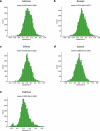Personal transcriptome variation is poorly explained by current genomic deep learning models
- PMID: 38036790
- PMCID: PMC10703684
- DOI: 10.1038/s41588-023-01574-w
Personal transcriptome variation is poorly explained by current genomic deep learning models
Abstract
Genomic deep learning models can predict genome-wide epigenetic features and gene expression levels directly from DNA sequence. While current models perform well at predicting gene expression levels across genes in different cell types from the reference genome, their ability to explain expression variation between individuals due to cis-regulatory genetic variants remains largely unexplored. Here, we evaluate four state-of-the-art models on paired personal genome and transcriptome data and find limited performance when explaining variation in expression across individuals. In addition, models often fail to predict the correct direction of effect of cis-regulatory genetic variation on expression.
© 2023. The Author(s).
Conflict of interest statement
The authors declare no competing interests.
Figures













